Quantum-Inspired Interpretable AI-Empowered Decision Support System for Detection of Early-Stage Rheumatoid Arthritis in Primary Care Using Scarce Dataset
Abstract
1. Introduction
The Importance of Early Diagnosis of Rheumatoid Arthritis in Primary Care
2. Background
2.1. Previous Works on Diagnosis of RA
2.2. Fuzzy Cognitive Maps
2.3. Particle Swarm Optimization
2.4. The QFCM Algorithm
3. Materials and Methods
3.1. Dataset
3.2. Proposed Method
| Algorithm 1 The QFCM algorithm, modified for classification problems |
Input: Patient’s Data Output: Fuzzy Cognitive Map
|
4. Experimental Results
4.1. Classification Accuracy
4.2. Weight Matrix of the FCM and Its Interpretability
4.3. Web Based DSS
5. Limitations
6. Conclusions
Author Contributions
Funding
Institutional Review Board Statement
Informed Consent Statement
Data Availability Statement
Acknowledgments
Conflicts of Interest
Appendix A
| Section/Topic | Item | Checklist Item | Page | |
|---|---|---|---|---|
| Title and Abstract | ||||
| Title | 1 | D;V | Identify the study as developing and/or validating a multi-variable prediction model, the target population, and the outcome to be predicted | 1 |
| Abstract | 2 | D;V | Provide a summary of objectives, study design, setting, participants, sample size, predictors, outcome, statistical analysis, results, and conclusions. | 1 |
| Introduction | ||||
| Background and objectives | 3a | D;V | Explain the medical context (including whether diagnostic or prognostic) and rationale for developing or validating the multi-variable prediction model, including references to existing models. | 1, 2, 3, 4, 5 |
| 3b | D;V | Specify the objectives, including whether the study describes the development or validation of the model or both. | 2 | |
| Methods | ||||
| Source of data | 4a | D;V | Describe the study design or source of data (e.g., randomized trial, cohort, or registry data), separately for the development and validation datasets, if applicable. | 5,6 |
| 4b | D;V | Specify the key study dates, including start of accrual; end of accrual; and, if applicable, end of follow-up. | 5, 6 | |
| Participants | 5a | D;V | Specify key elements of the study setting (e.g., primary care, secondary care, general population) including number and location of centres. | 5, 6 |
| 5b | D;V | Describe eligibility criteria for participants. | 5 | |
| 5c | D;V | Give details of treatments received, if relevant | 6 | |
| Outcome | 6a | D;V | Clearly define the outcome that is predicted by the prediction model, including how and when assessed. | 10 |
| 6b | D;V | Report any actions to blind assessment of the outcome to be predicted | N.A. | |
| Predictors | 7a | D;V | Clearly define all predictors used in developing or validating the multi-variable prediction model, including how and when they were measured. | 6 |
| 7b | D;V | Report any actions to blind assessment of predictors for the outcome and other predictors. | N.A. | |
| Sample size | 8 | D;V | Explain how the study size was arrived at. | N.A. |
| Missing data | 9 | D;V | Describe how missing data were handled (e.g., complete-case analysis, single imputation, multiple imputation) with details of any imputation method. | 6 |
| Statistical analysis methods | 10a | D | Describe how predictors were handled in the analyses. | 6 |
| 10b | D | Specify type of model, all model-building procedures (including any predictor selection), and method for internal validation. | 4, 5, 6 | |
| 10c | V | For validation, describe how the predictions were calculated. | 9 | |
| 10d | D;V | Specify all measures used to assess model performance and, if relevant, to compare multiple models. | 9, 10, 11, 12 | |
| 10e | V | Describe any model updating (e.g., recalibration) arising from the validation, if done. | N.A. | |
| Risk groups | 11 | D;V | Provide details on how risk groups were created, if done. | N.A. |
| Development vs. validation | 12 | V | For validation, identify any differences from the development data in setting, eligibility criteria, outcome, and predictors. | 9 |
| Results | ||||
| Participants | 13a | D;V | Describe the flow of participants through the study, including the number of participants with and without the outcome and, if applicable, a summary of the follow-up time. A diagram may be helpful. | N.A. |
| 13b | D;V | Describe the characteristics of the participants (basic demographics, clinical features, available predictors), including the number of participants with missing data for predictors and outcome. | N.A. | |
| 13c | V | For validation, show a comparison with the development data of the distribution of important variables (demographics, predictors and outcome). | N.A. | |
| Model development | 14a | D | Specify the number of participants and outcome events in each analysis | 10, 11, 12 |
| 14b | D | If done, report the unadjusted association between each candidate predictor and outcome. | 12, 13 | |
| Model specification | 15a | D | Present the full prediction model to allow predictions for individuals (i.e., all regression coefficients, and model intercept or baseline survival at a given time point). | 13, 14 |
| 15b | D | Explain how to the use the prediction model. | 9, 13, 14 | |
| Model performance | 16 | D;V | Report performance measures (with CIs) for the prediction model. | 10 |
| Model-updating | 17 | V | If done, report the results from any model updating (i.e., model specification, model performance). | N.A. |
| Discussion | ||||
| Limitations | 18 | D;V | Discuss any limitations of the study (such as non-representative sample, few events per predictor, missing data). | 13 |
| Interpretation | 19a | V | For validation, discuss the results with reference to performance in the development data, and any other validation data. | 10, 11, 12 |
| 19b | D;V | Give an overall interpretation of the results, considering objectives, limitations, results from similar studies, and other relevant evidence. | 10, 11, 12, 13 | |
| Implications | 20 | D;V | Discuss the potential clinical use of the model and implications for future research. | 14 |
| Other Information | ||||
| Supplementary information | 21 | D;V | Provide information about the availability of supplementary resources, such as study protocol, Web calculator, anddatasets. | 13, 14, 18, 19 |
| Funding | 22 | D;V | Give the source of funding and the role of the funders for the present study. | 15 |
References
- Mizoguchi, F.; Slowikowski, K.; Wei, K.; Marshall, J.L.; Rao, D.A.; Chang, S.K.; Nguyen, H.N.; Noss, E.H.; Turner, J.D.; Earp, B.E.; et al. Functionally distinct disease-associated fibroblast subsets in rheumatoid arthritis. Nat. Commun. 2018, 9. [Google Scholar] [CrossRef] [PubMed]
- Blavnsfeldt, A.B.G.; de Thurah, A.; Thomsen, M.D.; Tarp, S.; Langdahl, B.; Hauge, E.M. The effect of glucocorticoids on bone mineral density in patients with rheumatoid arthritis: A systematic review and meta-analysis of randomized, controlled trials. Bone 2018, 114, 172–180. [Google Scholar] [CrossRef] [PubMed]
- Scott, D.L.; Wolfe, F.; Huizinga, T.W. Rheumatoid arthritis. Lancet 2010, 376, 1094–1108. [Google Scholar] [CrossRef]
- Kitas, G.D.; Gabriel, S.E. Cardiovascular disease in rheumatoid arthritis: State of the art and future perspectives. Ann. Rheum. Dis. 2010, 70, 8–14. [Google Scholar] [CrossRef]
- Smith, J. Primary care: Balancing health needs, services and technology. Int. J. Integr. Care 2001, 1, e36. [Google Scholar] [CrossRef][Green Version]
- Green, L.A.; Fryer, G.E.; Yawn, B.P.; Lanier, D.; Dovey, S.M. The Ecology of Medical Care Revisited. N. Engl. J. Med. 2001, 344, 2021–2025. [Google Scholar] [CrossRef]
- Goldenberg, D.L. The Primary Care Provider’s Role in Diagnosing and Treating Rheumatoid Arthritis. Pract. Pain Manag. 2017, 17, 5. [Google Scholar]
- Heidari, B. Rheumatoid Arthritis: Early diagnosis and treatment outcomes. Casp. J. Intern. Med. 2011, 2, 161–170. [Google Scholar]
- Finckh, A. Early inflammatory arthritis versus rheumatoid arthritis. Curr. Opin. Rheumatol. 2009, 21, 118–123. [Google Scholar] [CrossRef]
- Abbasgholizadeh Rahimi, S.; Légaré, F.; Sharma, G.; Archambault, P.; Zomahoun, H.; Chandavong, S.; Rheault, N.; Wong, S.T.; Langlois, L.; Couturier, Y.; et al. Application of Artificial Intelligence in Community-Based Primary Health Care: Systematic Scoping Review and Critical Appraisal. J. Med. Internet Res. 2021, 23. [Google Scholar] [CrossRef]
- Salmeron, J.L.; Rahimi, S.; Navali, A.; Sadeghpour, A. Medical diagnosis of Rheumatoid Arthritis using data driven PSO-FCM with scarce datasets. Neurocomputing 2017, 232, 104–112. [Google Scholar] [CrossRef]
- Morita, K.; Tashita, A.; Nii, M.; Kobashi, S. Computer-aided diagnosis system for Rheumatoid Arthritis using machine learning. In Proceedings of the 2017 International Conference on Machine Learning and Cybernetics (ICMLC), Ningbo, China, 9–12 July 2017. [Google Scholar] [CrossRef]
- Singh, S.; Kumar, A.; Panneerselvam, K.; Vennila, J.J. Diagnosis of Arthritis through Fuzzy Inference System. J. Med. Syst. 2010, 36, 1459–1468. [Google Scholar] [CrossRef]
- Montejo, L.D.; Jia, J.; Kim, H.K.; Netz, U.J.; Blaschke, S.; Muller, G.A.; Hielscher, A.H. Computer-aided diagnosis of rheumatoid arthritis with optical tomography, Part 1: Feature extraction. J. Biomed. Opt. 2013, 18, 076001. [Google Scholar] [CrossRef]
- Duda, R.O.; Hart, P.E.; Stork, D.G. Pattern Classification, 2nd ed.; Wiley-Interscience: Hoboken, NJ, USA, 2000. [Google Scholar] [CrossRef]
- Kolahdoozi, M.; Amirkhani, A.; Shojaeefard, M.H.; Abraham, A. A novel quantum inspired algorithm for sparse fuzzy cognitive maps learning. Appl. Intell. 2019, 49, 3652–3667. [Google Scholar] [CrossRef]
- Kosko, B. Fuzzy cognitive maps. Int. J. Man-Mach. Stud. 1986, 24, 65–75. [Google Scholar] [CrossRef]
- Tolman, E.C. Cognitive maps in rats and men. Psychol. Rev. 1948, 55, 189–208. [Google Scholar] [CrossRef]
- Salmeron, J.L.; Mansouri, T.; Moghadam, M.R.S.; Mardani, A. Learning Fuzzy Cognitive Maps with modified asexual reproduction optimisation algorithm. Knowl.-Based Syst. 2019, 163, 723–735. [Google Scholar] [CrossRef]
- Bueno, S.; Salmeron, J.L. Benchmarking main activation functions in fuzzy cognitive maps. Expert Syst. Appl. 2009, 36, 5221–5229. [Google Scholar] [CrossRef]
- Stach, W.; Pedrycz, W.; Kurgan, L.A. Learning of Fuzzy Cognitive Maps Using Density Estimate. IEEE Trans. Syst. Man Cybern. Part B Cybern. 2012, 42, 900–912. [Google Scholar] [CrossRef]
- Salmeron, J.L. Fuzzy cognitive maps for artificial emotions forecasting. Appl. Soft Comput. 2012, 12, 3704–3710. [Google Scholar] [CrossRef]
- Kennedy, J.; Eberhart, R. Particle swarm optimization. In Proceedings of the ICNN’95—International Conference on Neural Networks, Perth, Australia, 27 November–1 December 1995; Volume 4, pp. 1942–1948. [Google Scholar] [CrossRef]
- Lahmiri, S. Minute-ahead stock price forecasting based on singular spectrum analysis and support vector regression. Appl. Math. Comput. 2018, 320, 444–451. [Google Scholar] [CrossRef]
- Jana, G.; Mitra, A.; Pan, S.; Sural, S.; Chattaraj, P.K. Modified Particle Swarm Optimization Algorithms for the Generation of Stable Structures of Carbon Clusters, Cn (n = 3–6, 10). Front. Chem. 2019, 7. [Google Scholar] [CrossRef] [PubMed]
- Hu, H.; Wang, H.; Bai, Y.; Liu, M. Determination of endometrial carcinoma with gene expression based on optimized Elman neural network. Appl. Math. Comput. 2019, 341, 204–214. [Google Scholar] [CrossRef]
- Papageorgiou, E.; Stylios, C.; Groumpos, P. Fuzzy Cognitive Map Learning Based on Nonlinear Hebbian Rule. In Lecture Notes in Computer Science; Springer: Berlin/Heidelberg, Germany, 2003; pp. 256–268. [Google Scholar] [CrossRef]
- Salmeron, J.L.; Ruiz-Celma, A.; Mena, A. Learning FCMs with multi-local and balanced memetic algorithms for forecasting industrial drying processes. Neurocomputing 2017, 232, 52–57. [Google Scholar] [CrossRef]
- Han, K.H.; Kim, J.H. Quantum-inspired evolutionary algorithm for a class of combinatorial optimization. IEEE Trans. Evol. Comput. 2002, 6, 580–593. [Google Scholar] [CrossRef]
- Moons, K.G.M.; Altman, D.G.; Reitsma, J.B.; Ioannidis, J.P.A.; Macaskill, P.; Steyerberg, E.W.; Vickers, A.J.; Ransohoff, D.F.; Collins, G.S. Transparent Reporting of a multivariable prediction model for Individual Prognosis or Diagnosis (TRIPOD): Explanation and elaboration. Ann. Intern. Med. 2015, 162, W1–W73. [Google Scholar] [CrossRef]
- Rahimi, S.A.; Jamshidi, A.; Ruiz, A.; Ait-kadi, D. A new dynamic integrated framework for surgical patients’ prioritization considering risks and uncertainties. Decis. Support Syst. 2016, 88, 112–120. [Google Scholar] [CrossRef]
- Löfgren, M.; Opava, C.H.; Demmelmaier, I.; Fridén, C.; Lundberg, I.E.; Nordgren, B.; Kosek, E. Pain sensitivity at rest and during muscle contraction in persons with rheumatoid arthritis: A substudy within the Physical Activity in Rheumatoid Arthritis 2010 study. Arthritis Res. Ther. 2018, 20. [Google Scholar] [CrossRef]
- Mok, C.C. Morning Stiffness in Elderly Patients with Rheumatoid Arthritis: What is Known about the Effect of Biological and Targeted Agents? Drugs Aging 2018, 35, 477–483. [Google Scholar] [CrossRef]
- West, S. Rheumatology Secrets E-Book; Elsevier Health Sciences: Amsterdam, The Netherlands, 2019. [Google Scholar]
- McWilliams, D.F.; Walsh, D.A. Pain mechanisms in rheumatoid arthritis. Clin. Exp. Rheumatol. 2017, 35, 94–101. [Google Scholar]
- Marhadour, T.; Jousse-Joulin, S.; ChalèS, G.; Grange, L.; Hacquard, C.; Loeuille, D.; Sellam, J.; Albert, J.D.; Bentin, J.; Valckenaere, I.C.; et al. Reproducibility of Joint Swelling Assessments in Long-lasting Rheumatoid Arthritis: Influence on Disease Activity Score-28 Values (SEA-Repro Study Part I). J. Rheumatol. 2010, 37, 932–937. [Google Scholar] [CrossRef]
- Isiksacan, Z.; Erel, O.; Elbuken, C. A portable microfluidic system for rapid measurement of the erythrocyte sedimentation rate. Lab Chip 2016, 16, 4682–4690. [Google Scholar] [CrossRef]
- Stach, W.; Kurgan, L.; Pedrycz, W.; Reformat, M. Genetic learning of fuzzy cognitive maps. Fuzzy Sets Syst. 2005, 153, 371–401. [Google Scholar] [CrossRef]
- Sierra, M.R.; Coello Coello, C.A. Improving PSO-Based Multi-objective Optimization Using Crowding, Mutation and ϵ-Dominance. In Evolutionary Multi-Criterion Optimization; Coello Coello, C.A., Hernández Aguirre, A., Zitzler, E., Eds.; Springer: Berlin/Heidelberg, Germany, 1995; pp. 505–519. [Google Scholar]
- Wang, L. (Ed.) Support Vector Machines: Theory and Applications; Springer: Berlin/Heidelberg, Germany, 2005. [Google Scholar] [CrossRef]
- Han, K.H.; Kim, J.H. Quantum-Inspired Evolutionary Algorithms with a New Termination Criterion, Hϵ Gate, and Two-Phase Scheme. IEEE Trans. Evol. Comput. 2004, 8, 156–169. [Google Scholar] [CrossRef]
- Lv, F.; Yang, G.; Yang, W.; Zhang, X.; Li, K. The convergence and termination criterion of quantum-inspired evolutionary neural networks. Neurocomputing 2017, 238, 157–167. [Google Scholar] [CrossRef]
- Diri, B.; Albayrak, S. Visualization and analysis of classifiers performance in multi-class medical data. Expert Syst. Appl. 2008, 34, 628–634. [Google Scholar] [CrossRef]
- Silveira, I.G.; Burlingame, R.W.; von Mühlen, C.A.; Bender, A.L.; Staub, H.L. Anti-CCP antibodies have more diagnostic impact than rheumatoid factor (RF) in a population tested for RF. Clin. Rheumatol. 2007, 26, 1883–1889. [Google Scholar] [CrossRef]
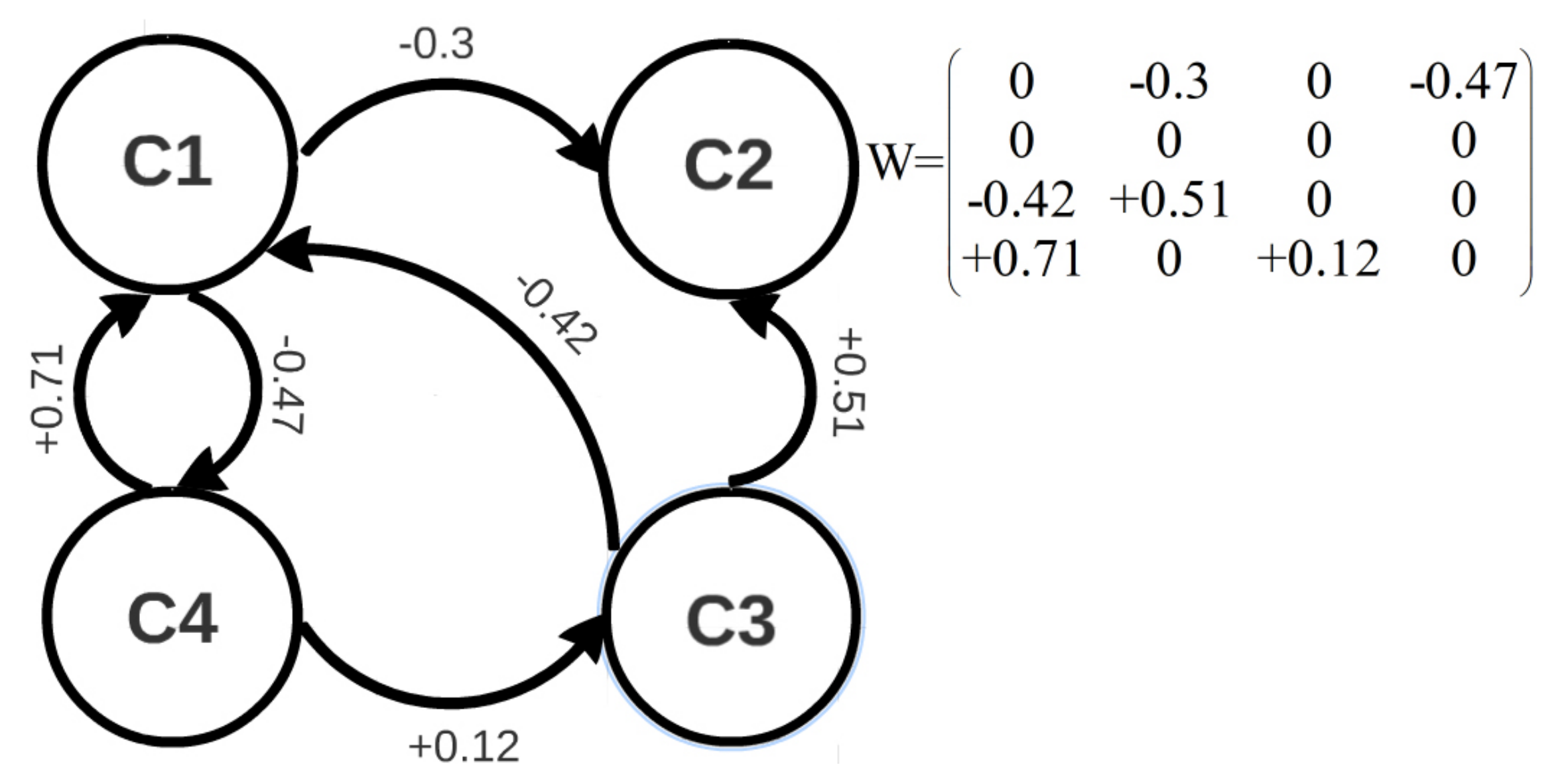
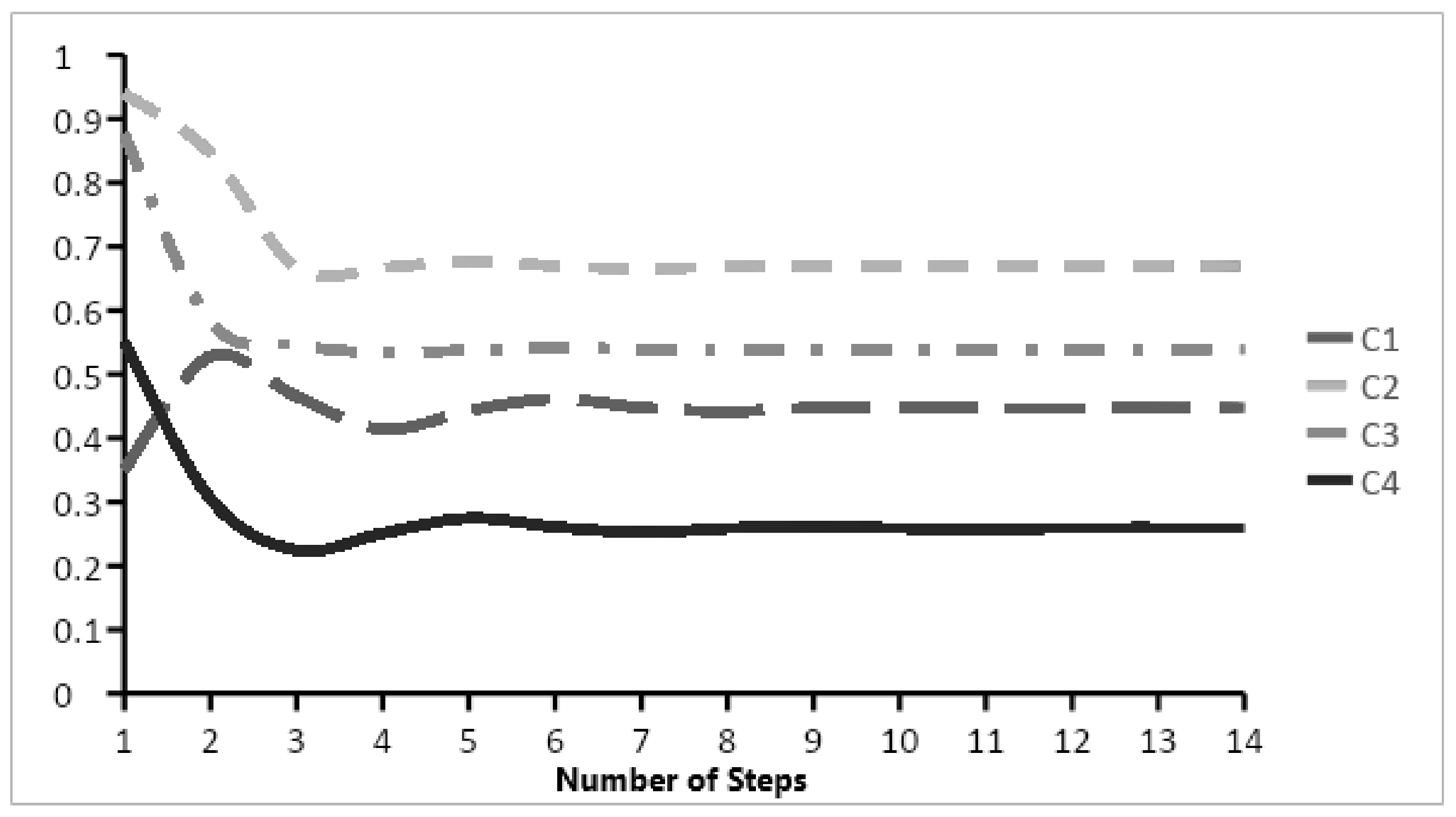
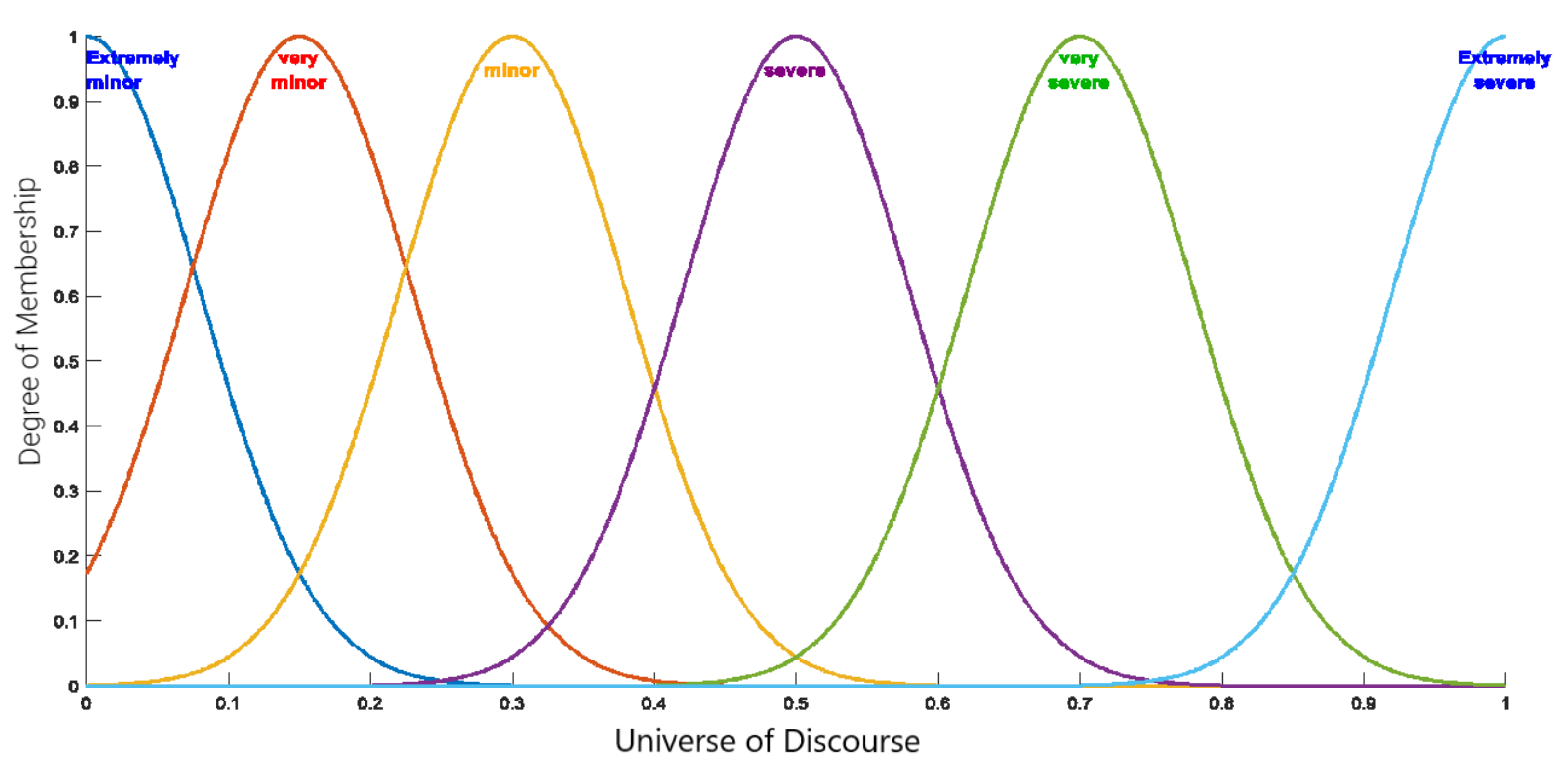
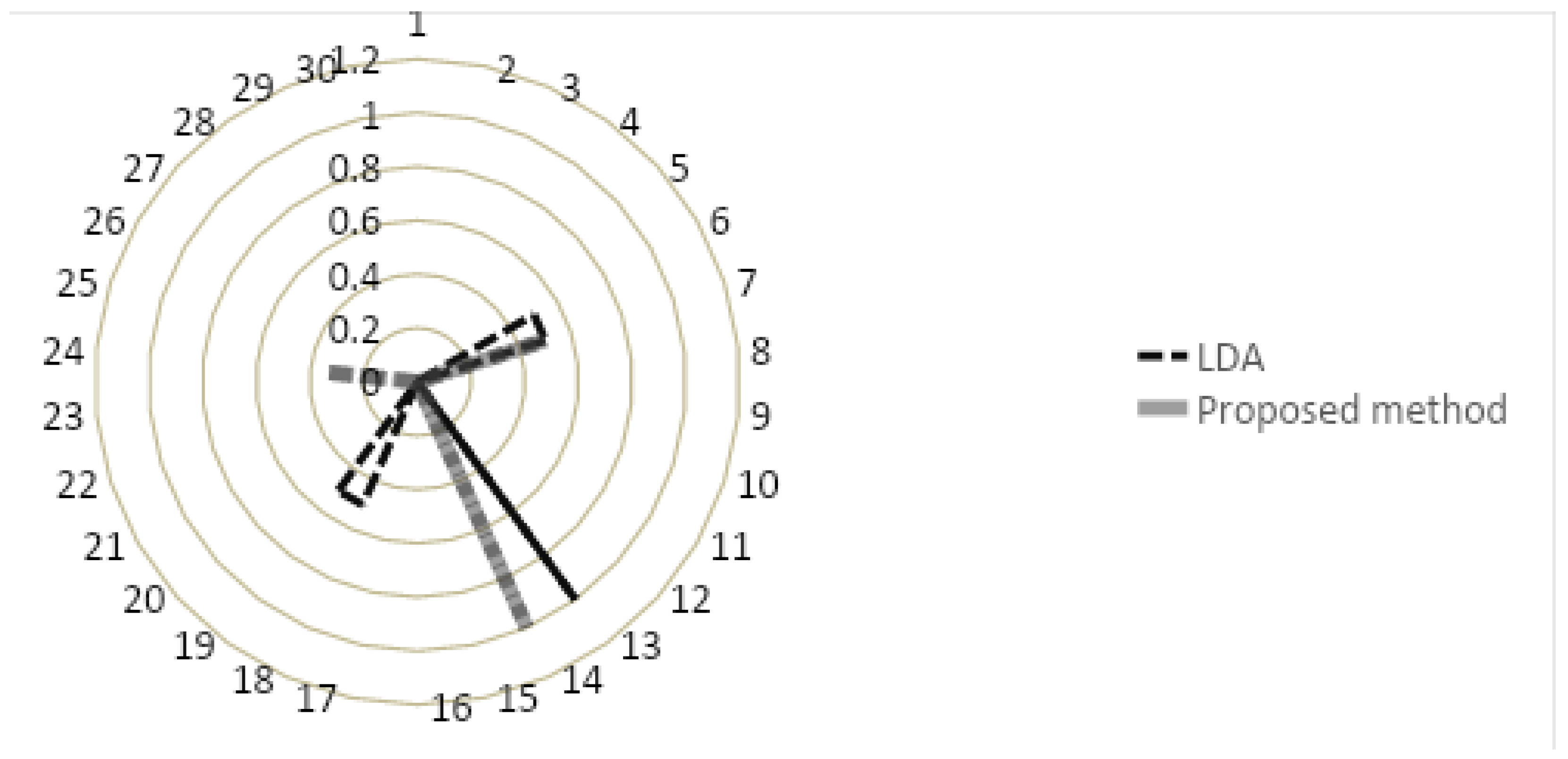
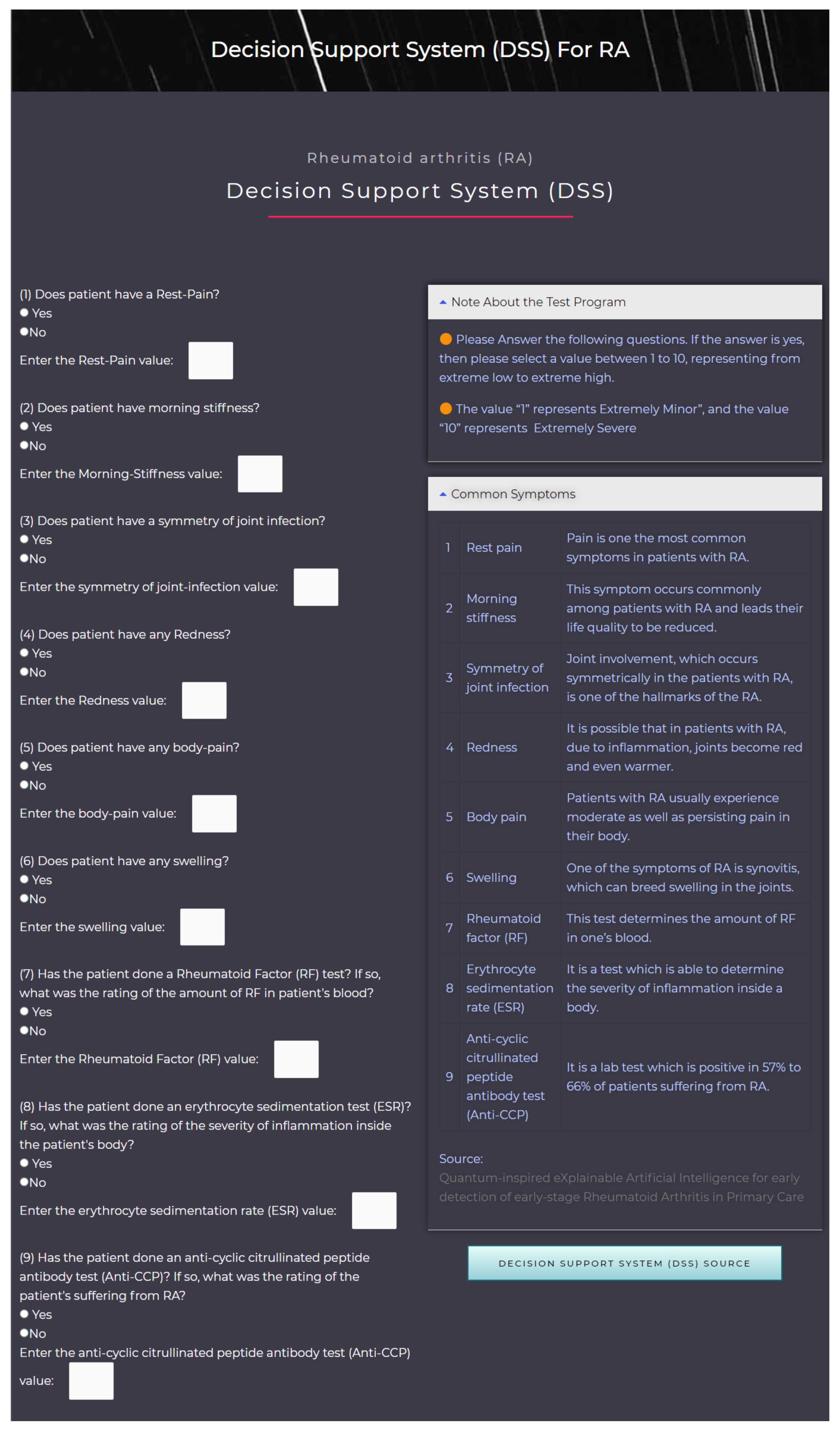

| Selected Criteria | Justification |
|---|---|
| C1: Rest pain | Pain is one the most common symptoms in patients with RA. While it is assumed to be interlinked with inflammation, in many cases, despite controlling the inflammation, the FL pain persists [32,33]. |
| C2: Morning stiffness | This symptom is common among patients with RA. Clinical trials have shown that the duration of this symptom is associated with reduced quality of life [34]. |
| C3: Symmetry of joint infection | Symmetrical joint involvement is a hallmark of RA. Patients usually have several infections in their joints [35]. |
| C4: Redness | Due to inflammation, joints may become red and warm in comparison to FL the surrounding tissue [35]. |
| C5: Body pain | Patients with RA usually experience moderate and persistent pain in their body [36]. |
| C6: Swelling | One symptom of RA, synovitis, can cause swelling in the joints [37]. |
| C7: Positive Rheumatoid factor (RF) test | This test determines the amount of RF in one’s blood. RFs, produced by immune system, are a kind of proteins which are able to destroy healthy tissue. In 70–80% of RA patients test positively for RF. This test has a specificity of 86% [35]. |
| C8: Elevated Erythrocyte sedimentation rate (ESR): | It is a test which is able to determine the severity of inflammation inside a body. It measures the pace at which erythrocytes falls. Patients with RA usually have elevated ESR, owing to hypergammaglobulinemia [35,38]. |
| C9: Positive Anti-cyclic citrullinated peptide antibody test (Anti-CCP) | 57% to 66% of RA patients have a positive-anti-CCP. Positive-anti-CCP patients usually have more severe RA with poor prognosis [35]. |
| No. | C1 | C2 | C3 | C4 | C5 | C6 | C7 | C8 | C9 | Severity (Class Label) |
|---|---|---|---|---|---|---|---|---|---|---|
| 1 | 0.85 | 0.7 | 0.5 | 0.3 | 0.5 | 0.7 | 0.7 | 0.7 | 0.7 | Extremely severe (5) |
| 2 | 1.0 | 0.7 | 0.5 | 0.3 | 0.5 | 0.7 | 0.7 | 0.7 | 0.7 | Extremely severe (5) |
| 3 | 0.5 | 0.7 | 0.5 | 0.3 | 0.5 | 0.3 | 0.3 | 0.5 | 0.5 | Very severe (4) |
| 4 | 0.7 | 0.5 | 0.5 | 0.3 | 0.5 | 0.3 | 0.7 | 0.7 | 0.3 | Very severe (4) |
| ⋮ | ||||||||||
| 10 | 0.15 | 0.15 | 0.15 | 0.3 | 0.15 | 0.5 | 0.3 | 0.5 | 0.3 | Very minor (1) |
| 11 | 0.0 | 0.15 | 0.15 | 0.0 | 0.15 | 0.15 | 0.15 | 0.5 | 0.15 | Very minor (1) |
| 12 | 0.15 | 0.0 | 0.15 | 0.0 | 0.15 | 0.15 | 0.0 | 0.3 | 0.15 | Extremely minor (0) |
| 13 | 0.0 | 0.0 | 0.15 | 0.0 | 0.15 | 0.15 | 0.0 | 0.3 | 0.15 | Extremely minor (0) |
| MaxIter | Global Migration Period | Local Migration Period | ||
|---|---|---|---|---|
| 1200 | 20 | 10 | 0.01 | 0.01 |
| Predicted | |||||||
|---|---|---|---|---|---|---|---|
| Actual | 0 | 1 | 2 | 3 | 4 | 5 | |
| 0 | 2 | 0 | 0 | 0 | 0 | 0 | |
| 1 | 0 | 1 | 1 | 0 | 0 | 0 | |
| 2 | 0 | 0 | 0 | 0 | 2 | 0 | |
| 3 | 0 | 0 | 0 | 2 | 0 | 0 | |
| 4 | 0 | 0 | 0 | 1 | 2 | 0 | |
| 5 | 0 | 0 | 0 | 0 | 0 | 2 | |
| Predicted | |||||||
|---|---|---|---|---|---|---|---|
| Actual | 0 | 1 | 2 | 3 | 4 | 5 | |
| 0 | 2 | 0 | 0 | 0 | 0 | 0 | |
| 1 | 1 | 0 | 1 | 0 | 0 | 0 | |
| 2 | 0 | 0 | 0 | 2 | 0 | 0 | |
| 3 | 0 | 0 | 1 | 0 | 1 | 0 | |
| 4 | 0 | 0 | 0 | 0 | 3 | 0 | |
| 5 | 0 | 0 | 0 | 0 | 0 | 2 | |
| Predicted | |||||||
|---|---|---|---|---|---|---|---|
| Actual | 0 | 1 | 2 | 3 | 4 | 5 | |
| 0 | 0 | 2 | 0 | 0 | 0 | 0 | |
| 1 | 1 | 0 | 1 | 0 | 0 | 0 | |
| 2 | 0 | 0 | 0 | 1 | 1 | 0 | |
| 3 | 0 | 0 | 1 | 0 | 1 | 0 | |
| 4 | 0 | 0 | 1 | 0 | 2 | 0 | |
| 5 | 0 | 0 | 0 | 0 | 2 | 0 | |
| Predicted | |||||||
|---|---|---|---|---|---|---|---|
| Actual | 0 | 1 | 2 | 3 | 4 | 5 | |
| 0 | 2 | 0 | 0 | 0 | 0 | 0 | |
| 1 | 1 | 1 | 0 | 0 | 0 | 0 | |
| 2 | 0 | 0 | 0 | 2 | 0 | 0 | |
| 3 | 0 | 0 | 2 | 0 | 0 | 0 | |
| 4 | 0 | 0 | 1 | 1 | 1 | 0 | |
| 5 | 0 | 0 | 0 | 0 | 0 | 2 | |
| Predicted | |||||||
|---|---|---|---|---|---|---|---|
| Actual | 0 | 1 | 2 | 3 | 4 | 5 | |
| 0 | 2 | 0 | 0 | 0 | 0 | 0 | |
| 1 | 1 | 0 | 1 | 0 | 0 | 0 | |
| 2 | 0 | 0 | 0 | 2 | 0 | 0 | |
| 3 | 0 | 0 | 2 | 0 | 0 | 0 | |
| 4 | 0 | 0 | 1 | 1 | 1 | 0 | |
| 5 | 0 | 0 | 0 | 0 | 0 | 2 | |
| Predicted | |||||||
|---|---|---|---|---|---|---|---|
| Actual | 0 | 1 | 2 | 3 | 4 | 5 | |
| 0 | 2 | 0 | 0 | 0 | 0 | 0 | |
| 1 | 1 | 1 | 0 | 0 | 0 | 0 | |
| 2 | 0 | 0 | 0 | 1 | 1 | 0 | |
| 3 | 0 | 0 | 2 | 0 | 0 | 0 | |
| 4 | 0 | 0 | 1 | 1 | 1 | 0 | |
| 5 | 0 | 0 | 0 | 0 | 0 | 2 | |
| Predicted | |||||||
|---|---|---|---|---|---|---|---|
| Actual | 0 | 1 | 2 | 3 | 4 | 5 | |
| 0 | 2 | 0 | 0 | 0 | 0 | 0 | |
| 1 | 1 | 0 | 1 | 0 | 0 | 0 | |
| 2 | 0 | 0 | 0 | 1 | 1 | 0 | |
| 3 | 0 | 0 | 1 | 0 | 1 | 0 | |
| 4 | 0 | 0 | 1 | 0 | 2 | 0 | |
| 5 | 0 | 0 | 0 | 0 | 0 | 2 | |
| Predicted | |||||||
|---|---|---|---|---|---|---|---|
| Actual | 0 | 1 | 2 | 3 | 4 | 5 | |
| 0 | 2 | 0 | 0 | 0 | 0 | 0 | |
| 1 | 0 | 2 | 0 | 0 | 0 | 0 | |
| 2 | 0 | 0 | 0 | 2 | 0 | 0 | |
| 3 | 0 | 0 | 0 | 1 | 1 | 0 | |
| 4 | 0 | 0 | 0 | 0 | 3 | 0 | |
| 5 | 0 | 0 | 0 | 0 | 0 | 2 | |
| Predicted | |||||||
|---|---|---|---|---|---|---|---|
| Actual | 0 | 1 | 2 | 3 | 4 | 5 | |
| 0 | 2 | 0 | 0 | 0 | 0 | 0 | |
| 1 | 0 | 1 | 1 | 0 | 0 | 0 | |
| 2 | 0 | 0 | 0 | 0 | 2 | 0 | |
| 3 | 0 | 0 | 1 | 0 | 1 | 0 | |
| 4 | 0 | 0 | 0 | 0 | 3 | 0 | |
| 5 | 0 | 0 | 0 | 0 | 0 | 2 | |
| LDA | Linear | Quadratic | Cubic | Fine | Weighted | |
|---|---|---|---|---|---|---|
| SVM | SVM | SVM | KNN | KNN | ||
| QFCM | 0.002 | 0.005 | 0.001 | 0.006 | 0.002 | 0.002 |
Publisher’s Note: MDPI stays neutral with regard to jurisdictional claims in published maps and institutional affiliations. |
© 2022 by the authors. Licensee MDPI, Basel, Switzerland. This article is an open access article distributed under the terms and conditions of the Creative Commons Attribution (CC BY) license (https://creativecommons.org/licenses/by/4.0/).
Share and Cite
Rahimi, S.A.; Kolahdoozi, M.; Mitra, A.; Salmeron, J.L.; Navali, A.M.; Sadeghpour, A.; Mir Mohammadi, S.A. Quantum-Inspired Interpretable AI-Empowered Decision Support System for Detection of Early-Stage Rheumatoid Arthritis in Primary Care Using Scarce Dataset. Mathematics 2022, 10, 496. https://doi.org/10.3390/math10030496
Rahimi SA, Kolahdoozi M, Mitra A, Salmeron JL, Navali AM, Sadeghpour A, Mir Mohammadi SA. Quantum-Inspired Interpretable AI-Empowered Decision Support System for Detection of Early-Stage Rheumatoid Arthritis in Primary Care Using Scarce Dataset. Mathematics. 2022; 10(3):496. https://doi.org/10.3390/math10030496
Chicago/Turabian StyleRahimi, Samira Abbasgholizadeh, Mojtaba Kolahdoozi, Arka Mitra, Jose L. Salmeron, Amir Mohammad Navali, Alireza Sadeghpour, and Seyed Amir Mir Mohammadi. 2022. "Quantum-Inspired Interpretable AI-Empowered Decision Support System for Detection of Early-Stage Rheumatoid Arthritis in Primary Care Using Scarce Dataset" Mathematics 10, no. 3: 496. https://doi.org/10.3390/math10030496
APA StyleRahimi, S. A., Kolahdoozi, M., Mitra, A., Salmeron, J. L., Navali, A. M., Sadeghpour, A., & Mir Mohammadi, S. A. (2022). Quantum-Inspired Interpretable AI-Empowered Decision Support System for Detection of Early-Stage Rheumatoid Arthritis in Primary Care Using Scarce Dataset. Mathematics, 10(3), 496. https://doi.org/10.3390/math10030496







